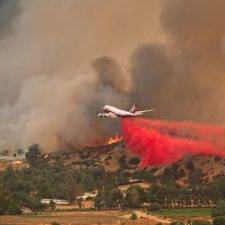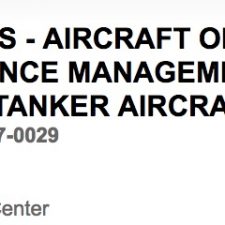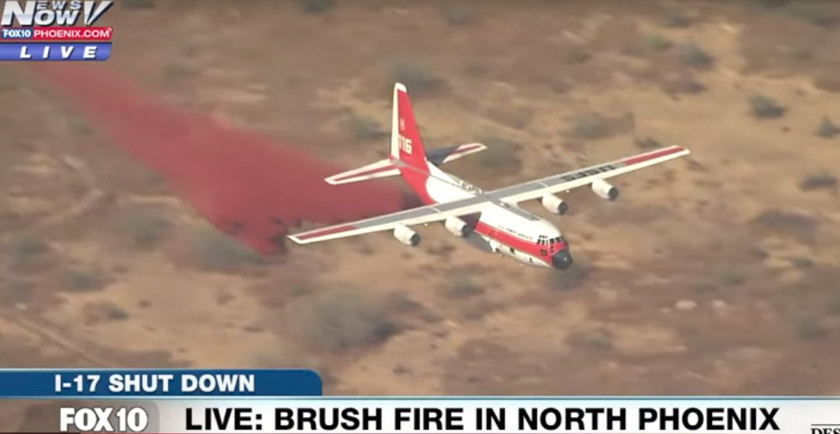Above: Air Tanker 944, a 747-400, drops near structures on the Palmer Fire south of Yucaipa, California at 4:25 p.m. PDT September 2, 2017. The aircraft was under a CWN contract with CAL FIRE. Photo by Leroy Leggitt, used with permission.
On June 15 the U.S. Forest Service issued solicitations for Call When Needed (CWN) air tankers. There are two separate requests for proposals (RFP), one for Large Air Tankers (LAT) and another for Very Large Air Tankers (VLAT).
The verbiage in the LAT document implies that, perhaps, only air tankers that have a capacity of 3,000 to 5,000 gallons will be considered:
Aircraft less than 3000 gallons or greater than 5000 gallons are not considered necessary or more desirable than aircraft in the target volume, given the priority mission for these airtankers is initial attack.
And the VLAT RFP “prefers” aircraft that can carry at least 8,000 gallons.
Aircraft with greater than 8000-gallon (72,000 pounds) dispensing capacity are preferred. Aircraft less than 8000 gallons are not considered necessary or more desirable than aircraft at the target volume, given the primary mission for these airtankers is large fire support.
It is interesting that the RFP has such imprecise language for this important specification, capacity, that can be easily required and measured. It is not subjective, unlike the editorial comments about one type of air tanker being prioritized for initial attack and another for large fire support. This assumes that LATs are not suitable for large fires and VLATs are not appropriate for initial attack. There are so few federally contracted air tankers available, now that the numbers have been cut again, that during periods of high fire activity too often no air tanker is going to arrive during the initial attack stage when a new fire is still small — unless it is on state land in California where CAL FIRE still believes in aggressive initial attack from both the ground AND the air. A VLAT, while carrying three to six times more than a LAT, can split their load, only dropping what is necessary, and land partially loaded with retardant if necessary.
The Government Accountability Office (GAO) and various congressional committees have been begging the Forest Service for many years to develop hard data to determine the effectiveness of firefighting aircraft and the liquids they drop on fires, so that better decisions can be made about how the $100 million appropriated annually for this activity should be spent.
The last time the Forest Service issued a solicitation for CWN air tankers was 222 days ago, on May 16, 2017. For the first time in their air tanker contracting history, according to the GAO, the FS at that time restricted the maximum size of retardant tanks, specifying the capacity must be between 3,000 and 5,000 gallons. This eliminated VLATs from being able to compete, since the DC-10 holds 11,600 gallons and the 747 carries up to 19,200.
Global Supertanker, the operator of a 747 VLAT, filed a protest which was upheld by the GAO. In their decision, the GAO wrote that the FS:
…failed to provide reasonable justifications for the challenged specification, such that we are unable to conclude that the challenged specification is reasonably necessary for the agency to meet its needs.
We recommend that the agency make a documented determination of its needs. Once the agency identifies its needs, the agency should revise its solicitation to include specifications that are reasonably necessary to meet those needs. We also recommend that the protester be reimbursed the costs of filing and pursuing the protest, including reasonable attorneys’ fees.
In 2012 the FS began a program to answer some of the questions about the effectiveness of firefighting aircraft, titled, Aerial Firefighting Use and Effectiveness (AFUE) Study. The agency’s stated goal was to begin releasing summaries of the results in 2017, but so far have not done so. A couple of weeks ago when we asked Vicki Christiansen, the Interim Chief of the Forest Service, when the study’s results would be released, she responded by email:
The summaries are not currently available. Unforeseen delays with staffing changes, retrieving aviation use data, and completing final reviews has delayed their overall schedule. The AFUE work group is continuing their work to complete the summaries and they will be provided as soon as they become available.



